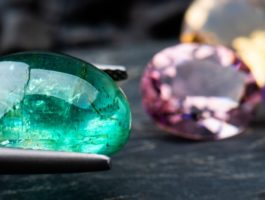Cutting Coloured Gems
The cutting of coloured gemstones is an entirely different process to that of cutting diamonds. As Terry Coldham advises, many more factors must be taken into account from the very start.

As they are all from a single mineral family, the physical and optical properties of individual diamonds are always very similar. Compare this with the mineral families to which coloured gemstones belong, each with different properties.
Some materials such as ruby can be especially valuable in its raw state – even more valuable than some diamond rough – while members of the quartz family, for example, can be very inexpensive.
This means, the lapidary must be more careful to maximise weight returns when cutting a ruby than, say, an amethyst. Cutting to preserve weight often results less than “ideal” cuts being acceptable.
The number of acceptable inclusions also depends on the value of the rough gem ( inclusions are more acceptable in rarer material). Take emerald and aquamarine, two members of the Beryl family.
Emeralds are often cut with inclusions that can improve their appearance. Conversely, cut aquamarines should be clean.
Such cut rules are prevalent in gem materials occurring rarely in large sizes. Peridot is common in small-sized pieces, used often to produce finely-cut calibrated stones 6mm or 7mm in size. Any peridot over this size is considered rare, and can be cut with less than ideal proportions to achieve good “show” and weight retention.
Characteristic shapes should also be taken into account when cutting gems. Emeralds, for example, usually occur as long, parallel-sided crystals ideally suited to cutting octagonal stones. This is why octagonal-cut gems are known as “emerald cut”.
As many other gemstones are recovered from river gravels where they occur as rounded pebbles much more suitable for cutting round shapes, an emerald-cut ruby may be worth more than a similar oval. All transparent materials have a specific refractive index (RI).
This index measures the speed in which light passes through them.
A stone with a high RI, such as zircon, usually appears “brighter” than one with a low RI, like topaz.
Each transparent gem material can be cut using ideal pavilionfacet angles to display maximum brilliance. Diamonds are almost invariably cut at “ideal” proportions using mathematically-calculated facet angles. Without wishing to state the obvious, coloured gemstones are usually fashioned to best display their colour. An easily recognized example of this would be opaque gem materials, such as lapis lazuli, being cut as cabochons.
Transparent gems often have other features that affect colour, the most common being pleochrosim – the display of different colours when viewed from different directions. The lapidary must orientate the material so that the finished product displays the most desirable colour.
Sometimes the body colour of the raw material is over light or over dark. The lapidary has to compensate for this by varying the “depth” of the cut stone away from proportions that would allow for maximum brilliance being displayed. Making things more difficult, the colour in a coloured gemstone is not always even Patches and colour bands must be positioned to best advantage.
By positioning areas of colour in or near the culet, the lapidary can turn a pale unevenly-coloured stone into one with greater appeal.
It can be seen that the factors that need to be taken into account when cutting a coloured stone are numerous, much more numerous than when cutting a diamond.
Essentially the lapidary has to take into account the following:
- The species of gem, including its size and shape, and its relative quality and value. This will dictate whether the stone is to be cut for maximum weight retention or maximum beauty.
- The clarity of the material and the degree of inclusions the market will tolerate. This will dictate what inclusions need to be sawn or ground off the rough, or if the inclusions can enhance the stone.
- The depth of colour, its distribution and the degree of any pleochroism. This will determine orientation of the cut stone and the depth of the finished gem.
The cutting of coloured gems is a compromise – does the lapidary opt for a “clean” stone, a stone of ideal colour, or one of perfect cut?
Cut stones rarely satisfy all of these factors, especially in more valuable gems. One of the anomalies of coloured gemstones is that cut quality becomes less important



